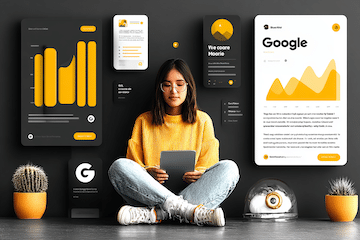
- Digital Customer Experience, UX Design, Website Design, Lead Generation
Recent articles
our mailing list
Master Lead Generation: A Comprehensive Guide to Crafting Killer Landing Pages

With the rise of digital marketing, creating targeted landing pages have become an essential tool for businesses looking to convert website visitors into leads.
However, creating an effective landing page that drives leads and boosts conversion rates is not always straightforward.
In this blog, we will provide a comprehensive overview of landing pages, their purpose, key elements, and optimisation tips.
Whether you are a seasoned marketer or just starting out, this post will help you understand how to use landing pages to maximise lead generation and drive business growth.
What exactly is a landing page?
These powerful, standalone web pages are designed to do one thing, and one thing only: convert visitors into leads.
Think of them as a bridge between the source of your traffic and the action you want them to take, whether that’s filling out a form or making a purchase.
Landing pages can be used for your digital marketing campaigns by directing traffic from Google or Facebook Ads, this is where the name ‘landing page’ comes from; i.e. where your users will land.
With a clear and attention-grabbing headline, an irresistible form for collecting lead info, and a can’t-miss call to action, landing pages pack a punch when it comes to boosting your conversion rates.
Importance of landing pages in lead generation
Let’s be clear. Landing pages are the unsung heroes of lead generation.
They are the front line of your digital marketing efforts, the make-or-break moment that can determine whether a visitor becomes a lead or simply bounces away.
The importance of landing pages cannot be overstated; they are the foundation for building a strong and effective lead generation strategy.
By focusing on a single goal and providing a seamless user experience, landing pages have been proven to drive targeted traffic and significantly improve conversion rates.
In today’s digital landscape, landing pages are a must-have for businesses looking to grow their customer base and generate more leads.
The Purpose of Landing Pages
1. To drive targeted traffic
Landing pages are like magnets for targeted traffic.
They allow you to attract the right audience to your website and guide them towards a specific action.
By providing a clear and compelling message that speaks directly to the needs of your target audience, landing pages can help drive targeted traffic and increase your chances of converting visitors into leads.
2. To provide a seamless user experience
Landing pages are all about delivering a seamless user experience.
They remove distractions and simplify the process of converting visitors into leads by removing distractions that may direct them away from your contact form.
By streamlining the process and making it easy for visitors to take action, landing pages can improve your conversion rate, increase leads, and help you take the conversation offline with a sales call.
3. To collect lead information
Landing pages are the key to collecting valuable lead information.
They provide a platform for you to gather important data such as contact information, preferences, and pain points.
The great thing about data collection on a landing page is you can customise the information gathered from your audience.
For example, if your standard website contact form only takes name, email and phone number, but on your landing page for a specific product or service, you can include tailored questions (that may not be relevant otherwise) to help prime your sales team in further converting that lead.
By a user submitting their interest on your landing page, you can work to provide sales and customer service that is unique to them.
Elements of a High-Converting Landing Page
As a digital marketing agency, it is our responsibility to advise our clients on creating the best landing pages for their industry, business and customer.
Over the years, we have created hundreds of landing pages and optimised many, many more. So some could say we’ve learned a thing or two.
Here’s our guide to creating the best landing pages;

1. A clear and compelling headline
Your headline is the first thing visitors see when they land on your page, and it’s critical to making a great first impression.
A clear and compelling headline sets the tone for the rest of the page, and it’s essential for catching the attention of visitors and making them want to stick around.
Make sure your headline is concise, relevant, and speaks directly to the needs of your target audience.
TIP: Avoid using jargon, keep your headline benefit-driven, so rather than telling them just what you provide, tell them what they can achieve by using your service or product.
2. An attention-grabbing hero image
An eye-catching hero image is the perfect complement to a clear and compelling headline.
It’s the first visual element visitors see, and it can make a big impact on the overall feel of your landing page.
Whether you choose a photo, illustration, or graphic, make sure your hero image is relevant, visually appealing, and sets the stage for the rest of your page.
3. A form for collecting lead information
The form is the heart of your landing page, and it’s where you’ll collect valuable lead information.
Make sure your form is simple and easy to use, with clear and concise fields that are relevant to your goals.
Also, consider the placement of your form, as well as its design, to ensure it’s eye-catching and not detracting from the rest of the page.
4. A strong call to action
A strong call to action (CTA) is the driving force behind your landing page, and it’s what prompts visitors to take action.
Your CTA should be clear, concise, and relevant to your goals.
Use action-oriented language and consider the placement, size, and colour of your CTA to ensure it stands out and makes an impact.
5. Social proof
Social proof is a psychological principle that states people are more likely to take an action if they see others doing it.
When it comes to landing pages, social proof can be a powerful tool for building trust and credibility with your audience.
Here are a few ways to incorporate social proof into your landing pages:
Testimonials:
One of the most effective forms of social proof is customer testimonials.
By showcasing real-life experiences from satisfied customers, you can build trust with visitors and demonstrate the value of your product or service.
Consider featuring testimonials in the form of written reviews or video testimonials.
Customer reviews:
Incorporating customer reviews into your landing page is another great way to build trust with visitors.
You can use a review aggregator like TrustPilot, Yelp or Google Reviews to showcase reviews and ratings, or you can include them directly on your page.
Case studies:
Case studies provide in-depth, real-world examples of how your product or service has helped other customers.
They provide a level of detail that testimonials and reviews don’t, and they can be a powerful tool for building credibility and demonstrating the value of your brand.
Trust badges:
Trust badges are logos or graphics that signal to visitors that your site is trustworthy and secure.
Examples of trust badges include VeriSign, McAfee, and the Better Business Bureau (BBB).
Displaying trust badges on your landing page can help build trust and increase conversions.
Social media followers:
Displaying the number of followers you have on social media can be a powerful form of social proof.
It shows that others trust and value your brand, which can increase trust and credibility with visitors.
By incorporating social proof into your landing page, you can build trust with visitors, demonstrate the value of your brand, and increase the chances of converting visitors into leads.
Optimising Landing Pages for Lead Generation
Segmenting your audience
Knowing your target audience is key to creating a landing page that resonates with visitors and drives lead generation.
That’s why segmenting your audience is an essential step in optimising your landing page.
By dividing your audience into smaller, more specific groups, you can tailor your landing page to the specific needs and interests of each group, increasing the chances of converting them into leads.
A/B testing
A/B testing is like a secret weapon for optimising your landing page.
A/B testing involves creating two versions of your landing page (A and B) and then testing which one performs better.
By making small changes to elements of your page, such as the headline, images, call to action, or form fields, you can determine what resonates best with your audience and make informed decisions about how to improve your page.
Here are a few tips for A/B testing your landing page:
Start small:
When it comes to A/B testing, it’s best to start small. Make one change at a time, and test it against the original version of your page. This way, you can determine the impact of each individual change and make informed decisions about what to keep and what to change.
Choose your metric:
Choose a metric to measure the success of your A/B test. Common metrics include conversion rate, bounce rate, and time on page. By selecting a metric to focus on, you can ensure that your test is aligned with your goals and objectives.
Test for a significant amount of time:
A/B testing takes time. It’s important to test each version of your page for a significant amount of time, ideally at least a week or more. This will ensure that you have enough data to make informed decisions about what works best.
Use tools to automate the process:
There are many tools available that can help automate the A/B testing process. From tools that track your visitors’ behaviour to tools that help you create and manage multiple versions of your page, these tools can help make A/B testing faster and easier.
Personalisation
Personalisation is a game changer when it comes to optimising landing pages for lead generation.
By tailoring your page to the specific interests and needs of individual visitors, you can create a more personalised and relevant experience that increases the chances of converting them into leads.
Whether it’s using visitor data to customise your page or using personalisation technology to create dynamic, real-time experiences, personalization is a powerful tool for improving your landing page’s performance.
Mobile optimisation
In today’s mobile-first world, it’s essential to ensure your landing page is optimised for mobile devices.
From responsive design to fast load times, there are many elements to consider when optimising your page for mobile.
By making sure your landing page is mobile-friendly, you can ensure that visitors have a seamless and positive experience, no matter what device they use, increasing the chances of converting them into leads.
Common Mistakes to Avoid
1. Overloading the page with too much information
Landing pages are meant to be simple, clear and concise, but it’s all too easy to overload them with too much information.
This can cause visitors to feel overwhelmed and quickly lose interest in your page.
To avoid this mistake, keep your page focused and avoid adding information that isn’t directly relevant to your lead generation goals
2. Poor design and user experience
Poor design and a subpar user experience can be a landing page’s downfall.
Visitors are quick to judge and even quicker to leave if they’re not impressed by what they see.
From cluttered layouts to confusing navigation, a lacklustre design can cause visitors to bounce before they even have a chance to convert.
So, how can you avoid this landing page faux pas?
The answer is simple: focus on creating a clean, professional, and user-friendly design that visitors will love.
Make sure your page is easy to navigate, with a clear hierarchy of information and an intuitive layout.
And, don’t forget about the little details, like font size and spacing, which can make a big impact on the overall user experience.
Remember, your landing page is the first impression visitors will have of your brand, so make it count!
3. No clear call to action
Your call to action is one of the most important elements of your landing page, and yet it’s often overlooked.
Without a clear and compelling call to action, visitors may not know what to do next or how to engage with your page.
To avoid this mistake, make sure your call to action is clear, prominent and aligned with your lead generation goals.
4. Not tracking and analysing performance metrics
Tracking and analysing performance metrics is crucial for understanding how your landing page is performing and identifying areas for improvement.
Without this information, you’re basically flying blind, unsure of what’s working and what’s not.
Think of it this way: how can you expect to make informed decisions and optimise your landing page for lead generation if you don’t have any data to guide you?
It’s like trying to drive a car without a speedometer or gas gauge – you’re just hoping for the best.
To avoid this common mistake, make sure to track and analyse performance metrics regularly.
Use tools like Google Analytics to monitor pageviews, bounce rates, and conversion rates.
And, remember the importance of A/B testing we mentioned before to see what resonates best with your audience.
The insights you gain from tracking and analysing performance metrics will help you continuously improve your landing page and achieve your lead generation goals.
A Refresher on the Vital Role of Landing Pages in Lead Generation:
As we’ve seen in this blog post, landing pages play a crucial role in lead generation by driving targeted traffic, providing a seamless user experience, and collecting valuable lead information.
By putting the right elements in place and continuously optimising your landing pages, you can create a powerful lead generation machine that delivers results.
So, what’s next?
If you want to tap into the full potential of landing pages and lead generation, why not let the experts at Sydney Digital Marketing help you out?
Our team of seasoned marketers and specialists can help you craft a winning lead generation strategy that includes killer landing pages that convert.
We’ll work with you every step of the way to ensure your landing pages are optimised for maximum results.
Contact us today!

Article by
Ben Kinnaird
General Manager / Sports Nut / Dad
Our captain of operations, Ben has over 15 years of experience in sales, marketing and all things digital. Before joining SDM in 2014, Ben worked as the Head of Marketing for Reebok APAC.[…]



